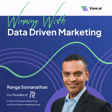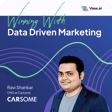
Power of Consumer Research: Lessons from Nestlé on how KitKat achieved 45% Sales Growth in a Year
Hosted by Julie from Vase.ai Market Research. In this episode, we speak with Anthony, a former VP at Nestle, about his experiences in building global brands and driving business growth across different countries such as Japan, China and Malaysia.
Anthony shares insights on the importance of data-driven marketing and the use of consumer research to drive innovation and renovation in product development. For example, he discusses how Nestle has used blind taste tests to increase the success rate of launching new product. He also shares how Nestle has used data to drive innovation and renovation in their product lines.Anthony also discusses the role of leadership in growing a business and the importance of sales experience in gaining marketing insights.
He shares how his own sales experience has helped him to better understand consumer needs and drive business growth. Throughout the episode, Anthony shares examples of how Nestle has used data to enhance ROI in marketing activities and drive business growth. For example, he discusses how Nestle has focused on marginal contribution to drive growth and how they have used consumer insights to pivot their business models.
In addition, Anthony discusses the importance of brand building and consumer delight in driving business growth. He shares how Nestle has focused on building consumer trust and delighting consumers with their products to drive brand loyalty and growth.
This episode is a must-listen for B2C marketers looking to gain insights on how to build global brands and drive business growth. Anthony’s experiences and insights provide valuable lessons for marketers looking to enhance their own marketing strategies.
In this episode, we discussed :
00:00 Introduction
01:25 Why Anthony stayed in Nestle for 30+ Years
16:14 The key success behind Nestle : Understanding what consumers want through consumer research
21:40 Case study on how KitKat increase 45% sales in a year with consumer research
24:34 Case Study of Reformulation of KitKat in China by listening to customer feedback
35:48 How Nestlé build a premium brand
36:23 How to turn research findings into actionable strategies
46:08 How Nestlé uses data to innovate new business model
46:30 Case Study of Nestlé campaign in China working with Alibaba on singles day
56:01 How Nestlé build brands that resonate with consumer
01:02:13 Lighting round - Advice for aspiring marketers
01:04:28 Lighting round - Key metrics that's being monitor
01:07:14 Lighting round - Recommended marketing book
For the full show notes, transcript and links, check out the episode page







